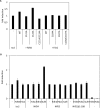Same but different: Comparison of two system-specific molecular chaperones for the maturation of formate dehydrogenases
- PMID: 30444874
- PMCID: PMC6239281
- DOI: 10.1371/journal.pone.0201935
Same but different: Comparison of two system-specific molecular chaperones for the maturation of formate dehydrogenases
Abstract
The maturation of bacterial molybdoenzymes is a complex process leading to the insertion of the bulky bis-molybdopterin guanine dinucleotide (bis-MGD) cofactor into the apo-enzyme. Most molybdoenzymes were shown to contain a specific chaperone for the insertion of the bis-MGD cofactor. Formate dehydrogenases (FDH) together with their molecular chaperone partner seem to display an exception to this specificity rule, since the chaperone FdhD has been proven to be involved in the maturation of all three FDH enzymes present in Escherichia coli. Multiple roles have been suggested for FdhD-like chaperones in the past, including the involvement in a sulfur transfer reaction from the l-cysteine desulfurase IscS to bis-MGD by the action of two cysteine residues present in a conserved CXXC motif of the chaperones. However, in this study we show by phylogenetic analyses that the CXXC motif is not conserved among FdhD-like chaperones. We compared in detail the FdhD-like homologues from Rhodobacter capsulatus and E. coli and show that their roles in the maturation of FDH enzymes from different subgroups can be exchanged. We reveal that bis-MGD-binding is a common characteristic of FdhD-like proteins and that the cofactor is bound with a sulfido-ligand at the molybdenum atom to the chaperone. Generally, we reveal that the cysteine residues in the motif CXXC of the chaperone are not essential for the production of active FDH enzymes.
Conflict of interest statement
The authors have declared that no competing interests exist.
Figures









Similar articles
-
In vitro sulfuration of Rhodobacter capsulatus formate dehydrogenase.J Biol Chem. 2025 Jun;301(6):108511. doi: 10.1016/j.jbc.2025.108511. Epub 2025 Apr 15. J Biol Chem. 2025. PMID: 40246024 Free PMC article.
-
The chaperone FdsC for Rhodobacter capsulatus formate dehydrogenase binds the bis-molybdopterin guanine dinucleotide cofactor.FEBS Lett. 2014 Feb 14;588(4):531-7. doi: 10.1016/j.febslet.2013.12.033. Epub 2014 Jan 18. FEBS Lett. 2014. PMID: 24444607
-
Sulfido and cysteine ligation changes at the molybdenum cofactor during substrate conversion by formate dehydrogenase (FDH) from Rhodobacter capsulatus.Inorg Chem. 2015 Apr 6;54(7):3260-71. doi: 10.1021/ic502880y. Epub 2015 Mar 24. Inorg Chem. 2015. PMID: 25803130
-
Assembly of membrane-bound respiratory complexes by the Tat protein-transport system.Arch Microbiol. 2002 Aug;178(2):77-84. doi: 10.1007/s00203-002-0434-2. Epub 2002 May 22. Arch Microbiol. 2002. PMID: 12115052 Review.
-
Assembly and catalysis of molybdenum or tungsten-containing formate dehydrogenases from bacteria.Biochim Biophys Acta. 2015 Sep;1854(9):1090-100. doi: 10.1016/j.bbapap.2014.12.006. Epub 2014 Dec 13. Biochim Biophys Acta. 2015. PMID: 25514355 Review.
Cited by
-
In vitro sulfuration of Rhodobacter capsulatus formate dehydrogenase.J Biol Chem. 2025 Jun;301(6):108511. doi: 10.1016/j.jbc.2025.108511. Epub 2025 Apr 15. J Biol Chem. 2025. PMID: 40246024 Free PMC article.
-
Second and Outer Coordination Sphere Effects in Nitrogenase, Hydrogenase, Formate Dehydrogenase, and CO Dehydrogenase.Chem Rev. 2022 Jul 27;122(14):11900-11973. doi: 10.1021/acs.chemrev.1c00914. Epub 2022 Jul 18. Chem Rev. 2022. PMID: 35849738 Free PMC article. Review.
-
Protein Engineering of the Soluble Metal-dependent Formate Dehydrogenase from Escherichia coli.Anal Sci. 2021 May 10;37(5):733-739. doi: 10.2116/analsci.20SCP15. Epub 2021 Jan 15. Anal Sci. 2021. PMID: 33455969
-
Metal-Containing Formate Dehydrogenases, a Personal View.Molecules. 2023 Jul 11;28(14):5338. doi: 10.3390/molecules28145338. Molecules. 2023. PMID: 37513211 Free PMC article. Review.
-
History of Maturation of Prokaryotic Molybdoenzymes-A Personal View.Molecules. 2023 Oct 20;28(20):7195. doi: 10.3390/molecules28207195. Molecules. 2023. PMID: 37894674 Free PMC article. Review.
References
-
- Leimkühler S, Iobbi-Nivol C. Bacterial molybdoenzymes: old enzymes for new purposes. FEMS microbiology reviews. 2016;40(1):1–18. Epub 2015/10/16. 10.1093/femsre/fuv043 . - DOI - PubMed
-
- Hille R. The mononuclear molybdenum enzymes. Chemical Rev. 1996;96:2757–816. - PubMed
-
- Palmer T, Vasishta A, Whitty PW, Boxer DH. Isolation of protein FA, a product of the mob locus required for molybdenum cofactor biosynthesis in Escherichia coli. Eur J Biochem. 1994;222:687–92. - PubMed
-
- Yokoyama K, Leimkühler S. The role of FeS clusters for molybdenum cofactor biosynthesis and molybdoenzymes in bacteria. Biochim Biophys Acta. 2014. Epub 2014/10/01. 10.1016/j.bbamcr.2014.09.021 . - DOI - PMC - PubMed
-
- Kisker C, Schindelin H, Rees DC. Molybdenum-cofactor-containing enzymes: structure and mechanism. Ann Rev Biochem. 1997;66:233–67. 10.1146/annurev.biochem.66.1.233 - DOI - PubMed
Publication types
MeSH terms
Substances
LinkOut - more resources
Full Text Sources
Miscellaneous

